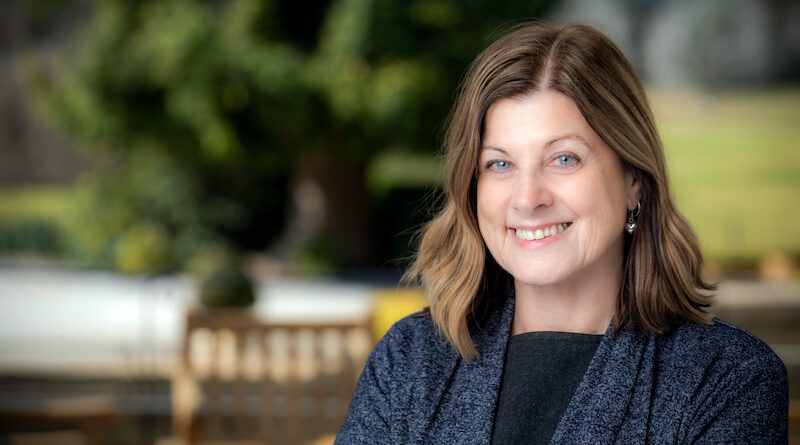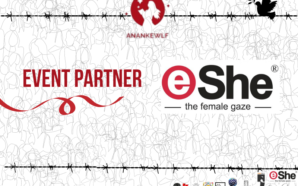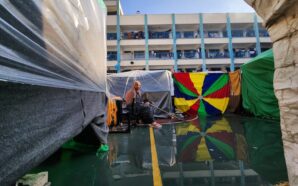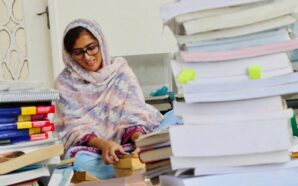Tell us a bit about yourself, your journey that led to The Fred Hollows Foundation
I live in Melbourne, Australia and I have lived here all my life. I am married to a guy who I met when he was on holidays here from Germany. He’s a Chef and we have two children – a daughter and a son, who are both in their 20s.
In terms of my professional career, I have worked in the government and non-government sectors all of my life; I’ve never been tempted to dabble in the private sector. My work has revolved around social marketing campaigns, changing behaviors, raising awareness, and influencing key decision makers. Particularly, in the last 15 years, my career has focused on advocacy in the health sector. I joined Vision 2020 Australia in 2004 as CEO and that was my first step into the eye health sector. Up until that point, I had worked in the health sector more broadly, disability, housing, and International Development areas, but not specifically in eye health.
I was CEO for Vision 2020 Australia for 11.5 years and The Fred Hollows Foundation was a member organization so I worked very closely with The Foundation and was impressed by the impact of the work they were doing both in Australia and internationally. While Vision 2020 Australia’s focus was primarily in Australia, working with members like The Foundation increased my interest in eye health in the international development sector and four years ago I was fortunate enough to be offered a position by The Fred Hollows Foundation.
I am passionate about, and am a champion for, gender equity – it is so important to me. My goal is to ensure gender equity is embedded across the eye health sector, both programmatically in the work that we and others do, but also within organizations like The Fred Hollows Foundation, because without walking the talk and living the values yourself, you cannot expect it to translate to the programs we, and others, deliver.
In addition to my work at The Foundation, I have been a Trustee on the Board of the International Agency for the Prevention of Blindness (IAPB) for a number of years and as part of that role, I have established a Gender Equity work group which I co-Chair with a female colleague who is from Tanzania in Africa.
I am passionate about gender equity because I am a female leader. But it is not only my own experience as a female leader that drives this passion, but also because of the challenges faced by other women that I have witnessed. I want to do my bit as an individual, but it is also critical that we mobilize, unite and gather more momentum compared to what we have had in the past.
I am also a member of a group called the International Women’s Forum, which has been around for many years. It is a movement that connects women locally and globally.
On a personal level I was fortunate to be offered a scholarship by Harvard University last year and am currently a 2020 Fellow in the Advanced Leadership Initiative which gives me an opportunity to further my social impact work more broadly.
With your work at Vision 2020 Australia and now at The Foundation, how do you think blindness discriminates when it comes to different groups and ethnicities… for example women, people with disabilities as well as the indigenous population?
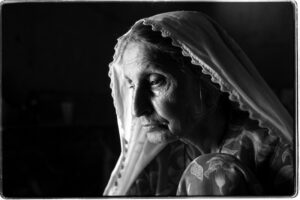
Hamir Danibux, pictured with a cataract in her right eye, at a 2002 three day microsurgical eye clinic in Shikarpur (Sindh Province of Pakistan). Photo courtesy of Jacky Ghossein.
Blindness indeed discriminates. Good vision is foundational and without it functioning in most aspects of our lives can be more difficult. This is most certainly exacerbated by social and economic disadvantage and clearly it becomes more profound amongst the poorest and the most marginalized. This group includes indigenous populations, people living with disabilities and, of course, you also have women and girls. Globally women are 1.3 times more likely to be blind than men which equates to 55% of the global population. This is the gender inequity we need to fix.
Trachoma is one of the leading infectious causes of blindness worldwide. It is prevalent in many countries around the world, particularly across Africa; however, it is also found in the Australian indigenous population and the statistics are far worse for women. It occurs four times as often in women compared to men and this is mainly because women are more likely to be in close contact with children and it is children who largely carry the infection. Typically, though, women are also less likely to get access to services like screening for eye health care.
The Fred Hollows Foundation is working in partnership with governments at a national level in over 25 countries. Globally, we are working hard to end all forms of discrimination against women and girls’ access to eye care and, wherever practical, we try to ensure that women actively participate and have a voice in their community. We want women to have full access to eye health services as well as leadership opportunities because the work goes hand in hand, but there is a lot more to be done.
Within the Global Goals for Sustainable Development, SDG 4 (Quality Education) and SDG 5 (Gender Equality) are both highly relevant to our work and intrinsically linked. Good vision is critical to enable participation in education. Looking around the world, you will see in many regions, girls, especially those who are vision impaired, find it impossible to access education and as a result, are marginalized and disadvantaged even further.
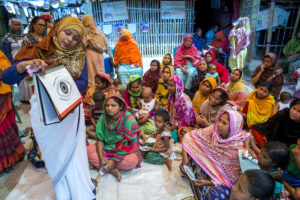
Bangladesh 2018.
We, at The Fred Hollows Foundation, believe that eye health and education are crucially interlinked because children with impaired vision, particularly those living in low- and middle-income countries face multiples challenges, including being less likely to attend school. Moreover, those children living with vision-impaired family members are held back to look after them and evidence tells us that this care-work responsibility usually falls on girls and women; they are not allowed to go to school so it just compounds the issue over generations. I also think even when children with vision loss do attend school, they are further discriminated and for girls, it is a double-edged sword: being female and vision impaired.
The Fred Hollows Foundation is working in this critical area of education by creating school screening spaces to identify children who require a pair of spectacles or need attention in some other way at home so that they can hopefully overcome some of those barriers.
How do you think the COVID19 pandemic has exacerbated existing inequalities especially in the eye health sector?
We need to acknowledge that there have been far reaching social and economic impacts of the COVID-19 pandemic, some of which we may not even recognize for some time to come; however, right now I believe COVID-19 has highlighted existing inequities in society and actually elevated them. But I also believe that in some ways, we have an opportunity to reset. I mean, not since the Spanish flu in 1918, one could argue, has the world been stopped it its tracks to this extent; this global pause, has brought to light these existing inequities. If we want to address them, now is the time for us to try and do that.
I agree with the UN Secretary General’s comment that women need to be put in the center of recovery otherwise we risk losing some of the gains that we have made over the last few decades. We must emerge from this crisis with women’s equal leadership and representation.
In a world, where even developed countries are experiencing different levels of regression in terms of gender equality, how can we now curb the negative impacts of blindness and vision impairment in the era of the post pandemic through advocacy?
I really believe there is an opportunity for the world to emerge from the pandemic and be more gender equal than what it was ever before; but it is going to take a lot of strong leadership and political will.
When you look at the health sector, women make up 70% of the global health workforce, but only hold 25% of the senior leadership roles. Moreover, there is a 26% gender pay gap in the health sector between men and women. This sort of gendered leadership imbalance and a pay gap in health is a major barrier in our efforts to achieve the SDGs by 2030. I remember a quote from an article I read recently that said “presently, in general, women deliver global health and men lead it”.
If empowering women and girls is critical for the well-being, economic and social developments, what is the key to achieve that: better policies, better implementation/integration, better partnership, awareness or anything else?
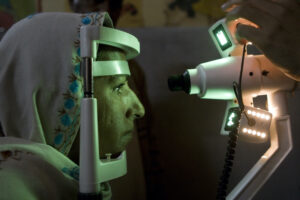
Prior to surgery, Razia Beghim gets her eyes examined through a slit lamp at Mayo Hospital (Lahore, Punjab province, Pakistan). Photo courtesty of www.lannonharley.com
I am pleased to say that up until the pandemic hit, and over the last several years, there have been some major breakthroughs and we can now see movement towards equity within the eye health space. Last year, there was a major development after years and years of advocacy work, when the World Health Organization (WHO) released its first ever ‘World Report on Vision’. It is hard to believe that it is the first time there has been a focus on vision. Building from this report, and despite the pandemic hitting, in August this year the World Health Assembly passed a resolution calling on all governments to commit to the Report’s recommendations. Within this report, there were two major themes; the first was to make eye health an integral part of universal health coverage and as we know, universal health coverage is about equity for all disadvantaged groups including women. The other theme was for countries to implement integrated people-centered eyecare, which comes down to ensuring that all groups, particularly disadvantaged groups, have equal access to eye care services.
The global emphasis on the SDGs has helped bring focus on the health sector ensuring we develop a holistic approach with development and sustainability embedded in its core.
The Fred Hollows Foundation is also actively engaged with the UN Friends of Vision group which is made up of UN ambassadors and led by the visionary and respected Dr. Aubrey Webson, the Ambassador to the United Nations for the island nation of Antigua and Barbuda. Dr Webson has mobilized a large group driving a UN resolution on ‘Vision for Everyone’. Assuming this resolution passes in early 2021, it will be an amazing development as it will position eye health as an economic and development issue within, and across, the SDGs.
 Having the World Health Assembly resolution pass this year was an incredible moment. It is something the eye health sector had been working towards for a long time and if the UN Resolution also passes, this is will be two major advocacy breakthroughs at a global level. These resolutions will see change filter down to the policy and programmatic level and lead to financial commitments. More broadly, this is about people’s empowerment and the importance of our health as an economic and development issue. I think these are important steps towards progress, and while we are not there yet, the fact that the UN is talking about a resolution is a major step forward.
Having the World Health Assembly resolution pass this year was an incredible moment. It is something the eye health sector had been working towards for a long time and if the UN Resolution also passes, this is will be two major advocacy breakthroughs at a global level. These resolutions will see change filter down to the policy and programmatic level and lead to financial commitments. More broadly, this is about people’s empowerment and the importance of our health as an economic and development issue. I think these are important steps towards progress, and while we are not there yet, the fact that the UN is talking about a resolution is a major step forward.
The Fred Hollows Foundation is creating tremendous impact across the world. Can you share some key takeaways from the Foundation’s immense journey?

Zeenat, 5 years old receives treatment at Hayatabad Medical Complex – Eye Department
I can give you two examples, one is from Pakistan, the other from Palestine.
In Pakistan, The Foundation is working at the grassroots level with lady health workers to overcome some of the barriers to access. This has resulted in increased community awareness, building up a really strong referral system from the community enabling access to primary care services for women. Referral systems, when they don’t work, are one of the key barriers not just in eye health, but across the health space. Certainly, in eye care, when the referral system works, it increases the number of women accessing outpatient services.
We have also done some advocacy work with local hospitals in Pakistan to find out what some of the barriers are and as a result, we introduced infant feeding areas as well as a separate waiting area in some of the hospitals. These are important insights that help identify barriers to eye health services for women and it is not always just a health barrier, it can also often be social barriers. As a result, we have developed training materials for our partners (local hospitals and other local service providers) and building from this work in Pakistan, these training materials have been locally contextualized for roll out with our work in Bangladesh, Nepal, China and Ethiopia.
In Palestine, we were shocked by the statistics which found roughly 62,000 men and 92,000 women with vision impairment highlighting the prevalence of blindness and vision impairment being significantly higher in women compared to men. We also saw data that showed that cataract surgery coverage in the study population was higher among men than women, meaning men who needed surgery were more likely to access it than their female counterparts. If this trend continues, the gender gap will rise significantly.
Working with our partner hospital and other healthcare providers in the West Bank and Gaza, we are conducting a gender analysis on eye care provision to understand where the barriers are and what measures we can take to ensure equity of access.
Across the eye health sector, there is often a lack of quality data collected, including sex disaggregated data, to enable effective gender analysis. I believe, being aware of this problem, puts The Fred Hollows Foundation ahead of the game. It is really important to understand the problems so that we can fix them once and for all, and tackle gender equity at all levels.
Images source: The Fred Hollows Foundation




